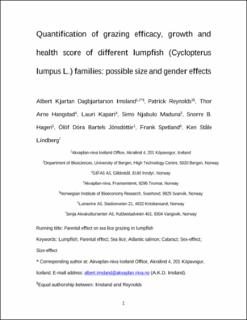| dc.contributor.author | Imsland, Albert | |
| dc.contributor.author | Reynolds, Patrick | |
| dc.contributor.author | Hangstad, Thor Arne | |
| dc.contributor.author | Kapari, Lauri Teemu | |
| dc.contributor.author | Maduna, Simo | |
| dc.contributor.author | Hagen, Snorre B. | |
| dc.contributor.author | Jónsdóttir, Ólöf Dóra Bartels | |
| dc.contributor.author | Spetland, Frank | |
| dc.contributor.author | Lindberg, Ken Ståle | |
| dc.date.accessioned | 2021-12-15T13:26:43Z | |
| dc.date.available | 2021-12-15T13:26:43Z | |
| dc.date.created | 2021-12-07T14:56:31Z | |
| dc.date.issued | 2021 | |
| dc.identifier.issn | 0044-8486 | |
| dc.identifier.uri | https://hdl.handle.net/11250/2834491 | |
| dc.description.abstract | To investigate the possible family influence on sea lice grazing of lumpfish on Atlantic salmon, ten families of lumpfish (N = 480) with a mean (± SD) weight of 54.8 ± 9.2 g were distributed among ten sea cages (5 × 5 × 5 m) each stocked with 400 Atlantic salmon with a mean (± SD) weight of 621.4 ± 9.2 g. All the ten cages were stocked with 48 lumpfish (12% stocking density). The stocking of cages was such that each cage consisted of two random families where full- and paternal half-sib families were randomly allocated to the different cages. There were clear differences in sea lice grazing efficacy, growth and cataract prevalence between the ten families assessed in this study. Lumpfish from families 2, 6 and 10 had the lowest mean weights but showed comparable growth rates compared to the other families throughout the study and this may be as a direct result of genetic influence. In addition, fish from these families had a significantly higher incidence of lice grazing of both L. salmonis and C. elongatus compared to the other families. Using mixed linear model to analyse the data revealed significant family and paternal effect on sea lice grazing. There was a trend for a reduction in sea lice grazing with increased size within each family. The results indicated that it was the smallest size classes of lumpfish (40–140 g) which exhibited higher sea lice grazing potential compared to the larger size classes within families. There were no clear differences in the lice grazing potential between male and female lumpfish within and between families. Overall, present findings showed that sea lice grazing of both L. salmonis and C. elongatus can be enhanced using targeted family production and if this behaviour has a genetic basis it may further enhanced through selection and targeted breeding programs. | en_US |
| dc.language.iso | eng | en_US |
| dc.publisher | Elsevier | en_US |
| dc.rights | Attribution-NonCommercial-NoDerivatives 4.0 Internasjonal | * |
| dc.rights.uri | http://creativecommons.org/licenses/by-nc-nd/4.0/deed.no | * |
| dc.title | Quantification of grazing efficacy, growth and health score of different lumpfish (Cyclopterus lumpus L.) families: possible size and gender effects | en_US |
| dc.type | Journal article | en_US |
| dc.type | Peer reviewed | en_US |
| dc.description.version | acceptedVersion | en_US |
| dc.rights.holder | Copyright 2020 Elsevier | en_US |
| dc.source.articlenumber | 735925 | en_US |
| cristin.ispublished | true | |
| cristin.fulltext | postprint | |
| cristin.qualitycode | 2 | |
| dc.identifier.doi | 10.1016/j.aquaculture.2020.735925 | |
| dc.identifier.cristin | 1965704 | |
| dc.source.journal | Aquaculture | en_US |
| dc.identifier.citation | Aquaculture. 2021, 530, 735925. | en_US |
| dc.source.volume | 530 | en_US |

